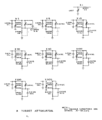Z: Difference between revisions
No edit summary |
No edit summary |
||
| Line 8: | Line 8: | ||
series=[[500-series scopes]]| | series=[[500-series scopes]]| | ||
manuals= | manuals= | ||
* [[Media:070-251.pdf|Tektronix Type Z Manual | * [[Media:070-251.pdf|Tektronix Type Z Manual]] (PDF, OCR) | ||
* [[Media:tek_type_z_fcp.pdf|Tektronix Type Z Factory Calibration Procedure (PDF)]] | * [[Media:tek_type_z_fcp.pdf|Tektronix Type Z Factory Calibration Procedure (PDF)]] | ||
}} | }} | ||
The '''Tektronix Type Z''' is a comparator plug-in for [[500-series scopes]] | The '''Tektronix Type Z''' is a comparator plug-in for [[500-series scopes]], [[introduced in 1960]] and dropped after 1968. | ||
The Type Z has two inputs, A and B, plus a precision comparison voltage, V<sub>C</sub>, that is | The Type Z has two inputs, A and B, plus a precision comparison voltage, V<sub>C</sub>, that is | ||
adjustable from 0 to | adjustable from 0 to ±1 V, 10 V, or 100 V via a ten-turn pot. | ||
Unlike later comparators, | The following differential amplifier can be configured to display V<sub>A</sub>, −V<sub>B</sub>, | ||
V<sub>A</sub>−V<sub>B</sub>, V<sub>A</sub>−V<sub>C</sub>, or V<sub>C</sub>−V<sub>B</sub>. | |||
This allows DC-coupled measurements of small signals with large DC offsets. | |||
Unlike later comparators, Type Z has separate step attenuators for each input, | |||
permitting the user to view the difference between signals of widely differing amplitudes. | permitting the user to view the difference between signals of widely differing amplitudes. | ||
It is also the only comparator that can handle | |||
It is also the only comparator that can handle ±100 V common mode at full sensitivity. | |||
With a pair of "Disconnect Signal" buttons, the Type Z was the first of the | With a pair of "Disconnect Signal" buttons, the Type Z was the first of the | ||
movement toward a "GND" position on the input switches. | movement toward a "GND" position on the input switches. | ||
The Type [[P6023]] probe with R and C compensation, [[introduced in 1962]], | The Type [[P6023]] probe with R and C compensation, [[introduced in 1962]], | ||
| Line 43: | Line 33: | ||
==Specifications== | ==Specifications== | ||
Maximum sensitivity is 50 mV/div, and common-mode rejection at DC and low frequencies is 40,000 to 1. | |||
Risetime as a general-purpose amplifier is 27 ns (13 MHz bandwidth), but it can track a common-mode risetime of 7 ns. | |||
[[Category:Specifications needed]] ''please add'' | [[Category:Specifications needed]] ''please add'' | ||
==Internals== | |||
The Type Z uses both tubes and transistors, capitalizing on the strengths of each. | |||
The step attenuators are [[turret attenuators]]. | |||
==Links== | ==Links== | ||
| Line 51: | Line 50: | ||
<gallery> | <gallery> | ||
Tek z front.jpg| | Tek z front.jpg|3/4 View | ||
Tek z 1.jpg| Front View | Tek z 1.jpg| Front View | ||
Tek z 7.jpg | Front View | Tek z 7.jpg | Front View | ||
Revision as of 03:21, 1 February 2021
Template:Plugin Sidebar 2 The Tektronix Type Z is a comparator plug-in for 500-series scopes, introduced in 1960 and dropped after 1968.
The Type Z has two inputs, A and B, plus a precision comparison voltage, VC, that is adjustable from 0 to ±1 V, 10 V, or 100 V via a ten-turn pot.
The following differential amplifier can be configured to display VA, −VB, VA−VB, VA−VC, or VC−VB.
This allows DC-coupled measurements of small signals with large DC offsets.
Unlike later comparators, Type Z has separate step attenuators for each input, permitting the user to view the difference between signals of widely differing amplitudes.
It is also the only comparator that can handle ±100 V common mode at full sensitivity.
With a pair of "Disconnect Signal" buttons, the Type Z was the first of the movement toward a "GND" position on the input switches.
The Type P6023 probe with R and C compensation, introduced in 1962, was specifically designed for the Type Z but also marketed for the Type G.
Specifications
Maximum sensitivity is 50 mV/div, and common-mode rejection at DC and low frequencies is 40,000 to 1.
Risetime as a general-purpose amplifier is 27 ns (13 MHz bandwidth), but it can track a common-mode risetime of 7 ns. please add
Internals
The Type Z uses both tubes and transistors, capitalizing on the strengths of each.
The step attenuators are turret attenuators.
Links
Pictures
-
3/4 View
-
Front View
-
Front View
-
Pre-production Type Z with different knob color
-
Left Side
-
Left Side
-
Right Side
-
Right Side
-
Right Side
-
Right Side Tubes
-
Top
-
Rear
Schematic
-
Attenuators
-
Main Amplifier













